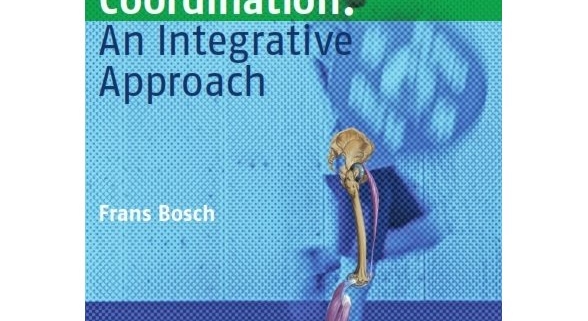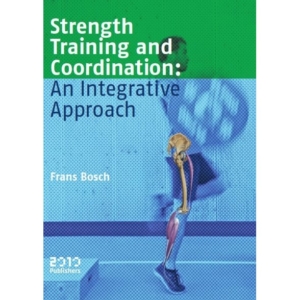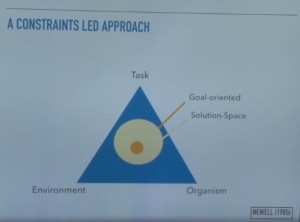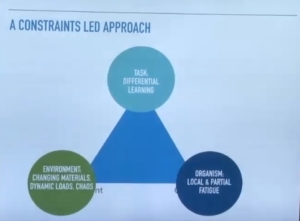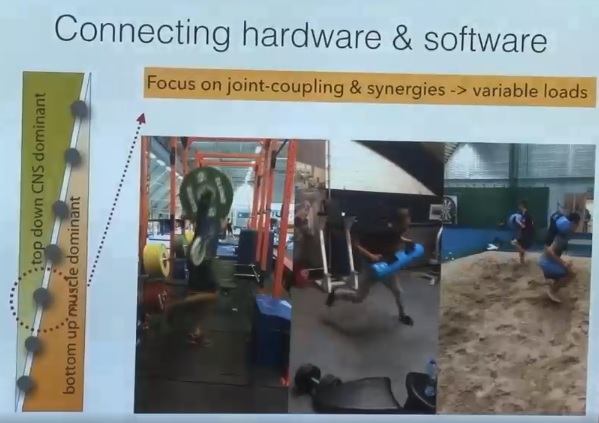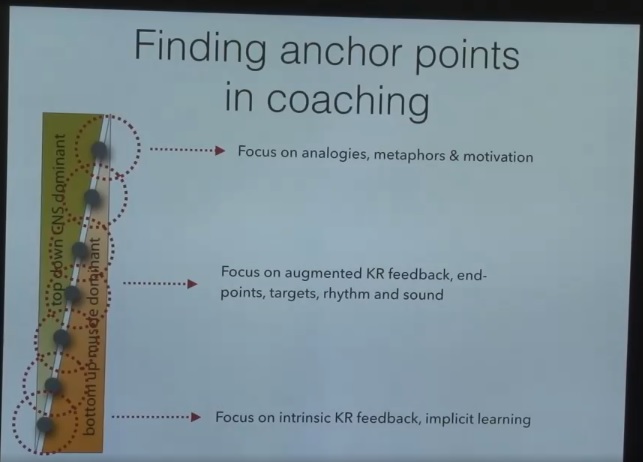How Do We Learn To Move? – Part 1
This blog has been simmering for a few years now. I wanted to share my experiences as someone who has been coaching for 20 years, and has subscribed to one particular philosophy of coaching athletes how to move- only to move away from this way in recent years.
The traditional information processing approach to skill – using internal models and knowledge to predict the outcome of our actions, is one I have followed for many years. Over the last few years I have been adopting an approach that is more consistent with the ideas of exploration, self-organisation, and connecting with your environment.
Like any journey (in this case my professional development) there are various people and concepts that influence you along the way. Some of these concepts have been in my consciousness for as long as I can remember – but there has been a shift in recent years to apply them.
I learnt about Motor Learning Principles first in University in the late 1990s, looking at the concept of Differential Learning – blocked versus random practice. This was a topic I also referred to in a few blogs and linked to a talk Dr Mike Young did several years ago – Motor Learning Concepts all Coaches Should Know‘ I had read some of James Gibson’s work on Ecological Dynamics Approach and ”Affordances” around 10 years ago, and was aware of the growing buzz around ”Constraints Lead Approach (CLA).” But I largely kept it in the background.
In 2012 I heard Frans Bosch speak for the first time, at the UKSCA Conference – Transfer of Strength Training – Implications from How the Central Nervous System works. He was the Keynote speaker on the first Saturday morning. It’s probably unfair to generalise for the whole audience, but I did feel that at that point in time the predominantly Newtonian biased audience of coaches were quick to reject the ideas of Fran and defaulted to the idea that Force = Mass x acceleration, and the more the better, is more important than the control of Force during sporting tasks.
I bought Frans Bosch’s second book in 2017 (first published 2015) but left it on the book shelf for the first year, waiting for the right time to be drawn back to it.
Fast forward to June 2018 and Chris McLeod – who just started as the Lawn Tennis Asociation (LTA) Lead S&C coach. Chris is someone that clearly had a refreshing outlook on how to address skill acquisition and it wasn’t long before he was inviting interesting and innovative coaches to speak to some of us involved in British Tennis. In August 2019 he invited Danny Newcombe to present on ‘Movement Puzzles,’ and specifically diving into CLA.
Around this period I went to visit Steffan Jones to learn about some of his training methods in fast bowling and cricket and it seemed the World was sending me a message that this topic was one I needed to pay attention to. He was instrumental in giving me the nudge to invest more time in understanding the principles of Frans Bosch.
The presentation of Danny Newcombe coincided with the first year of one of my junior coaches Gabe Fishlock working at APA in April 2019 – Gabe would go on to stay with us for almost two years until January 2021. I often use Gabe as an example of a ”positive disruptor,” a coach who challenges the status quo and helps evolve the programme.
Time for a Change
Gabe had been following the syllabus we had in place at APA which was largely based on the the traditional approach of learning a number of discrete motor skills in isolation through rote repetition – and the concept of developing mastery through drills. I could tell he never felt at ease coaching within this framework and thankfully he had the courage to challenge the status quo- and ask if he could re-write the syllabus over the summer break for the next term.
I’ll come back to this story in Part 2 of this blog, but for now it is enough to say that this was certainly the catalyst for change – and a new era of coaching. We had the pandemic from March 2020 – August 2020 so I guess it’s only really the last 2 years that the syllabus has been in full flow.
It would be easy to stop there and be content that APA has made it’s own positive dent in the coaching landscape but I’m always trying to develop what we do – and as I write this I still feel that while we say we adopt an approach to coaching that fosters self-organisation, and we use methods such as CLA, if I’m honest I think we still have a long way to go- myself included.
Present Day
In the last few months I’ve been further inspired to dig deeper after hearing Paul Venner – Frans Bosch System & Aquabag, who was someone I heard about having read about Randy Sullivan’s Savage Method in Baseball.
Two weeks ago I finally read Rob Gray’s ‘How We Learn to Move” book and found it really helped to consolidate all the various bits of research and sound bites into a coherent explanation that helped to solidify my understanding of the scientific research.
Today I’d like to share a few insights from Paul Venner’s presentation (Part 1) and I’ll follow up with a summary of some of the main findings I took away from Rob’s book (Part 2). This will certainly be just the highlight reel, the tip of the iceberg and I encourage you to seek out the original information for yourself.
Paul Venner – Frans Bosch System
The following sections are based on a presentation I listened to with Paul Venner in 2020 prior to the Pandemic.
Sometimes we have a situation where we have an athlete with a very stable pattern, but it is not optimal. Think of a runner who has a hip drop as they are running, so it’s stable but it’s passive stability as they move into the end range of the (hip) joint. This way they lose performance and they increase injury risk.
So what we need to do is first show them that it is not optimal, and put them in a position where they are going to get feedback about this passive movement (solution) that they are using. So for example, using a perturbation of the pattern so they are going to feel it and notice that it is actually not a good pattern.
Basically, this is what Motor Learning is – moving through this landscape of Stability
This landscape of stable points is moving throughout our development – firstly as a baby, then moving through to adolescence with growth spurts and later even as an adult whenever we learn a new skill- finding the optimal stable points to help control movement.
If someone has a stable but sub-optimal pattern, it is not enough to ‘teach” a better pattern because it’s so deep/engrained in the system (deep attractor well) that they will always fall back to the original pattern- and their old way of doing it. SO we have to get rid of that old pattern and make it unstable.
The model that we use for this coaching is the ”Constraints Lead Approach (CLA).” The movement emerges through the interaction of the TASK, ENVIRONMENT and ORGANISM. So the better we know the constraints of the organism, the task and the environment, the better we can manipulate those constraints in order to get a different movement outcome emerging.
If I have a goal orientated approach I can eventually increase the total solution-space – which is the space in which I can be successful.
Broadly speaking, instead of doing the same repetition 20 times in a row, I do one or two repetitions in a certain way, and then do something else. This may also include doing things that are not optimal, because by doing it someone will get a feel that it is not optimal so it is much more about having variation in the task.
Bottom Up Vs Top Down
There are two predominant theories that coaches use to explain how we learn skills – one based on a ”top down” computational model (CNS dominant) and the other based on a ”bottom up” dynamic systems model (muscle dominant).
Actually of course, it’s a bit of both! Yes we have a lot of stuff going on from top down, and yes we have a lot of stuff going on from bottom up, and it’s about how we can put them together.
What I have aimed to do with my baseball training is seeing where the anchor points are where both meet each other. I think of it like a road map of the country, and I identify all the places where all the traffic comes together [Daz comment- such as when cars are converging on London from the North and South around the M25 – for a UK based analogy].
- CNS dominant – anything with very High Intensity –> building maximum strength in optimal range.
- Focus on maximum power with pre-tension – with little or no external load (in max strength training the load builds tension, but out on the field I don’t have external load so I have to build it myself). This is based on the concept of muscle slack, and getting rid of it! I want to be able to get up without going down first and the way to train that is with pre-tension and using no load or changing loads such as aqua bags to train this ”co-contraction” control.
- Focus on rhythm in jumps, bounds & plyometrics
- Focus on reflex patterns development – cross extensor flexion reflex etc
- Focus on joint-coupling & synergies –> variable loads
- Focus on neuromuscular development –> time pressure & complexity (it’s too much information for the brain to cope with and there is a limitation on this transition from CNS to the muscular). You get very quick fatigue but you get very quick recovery, so you can do this even on game days.
- Focus on preflex development –> co-contractions & pertubations
Finding the Anchor Points in Our Coaching
In our coaching we can also find those anchor points so if we coach in a more brain dominant way – and talking a lot – I like to focus on keeping my talking only to the level of using analogies, metaphors & motivation – I try to do as little talking as possible, create the environment, and let the movement do the talking.
On the deeper level I can have knowledge of result information so that I get feedback from the exercise because I hit my target, I used a certain rhythm, I made a certain sound.
On the lowest level I can have intrinsic knowledge of results which is information that I get from within the body, this implicit learning through a feeling. It takes longer to establish but it is way more robust if we learn that way!
Exploration Versus Exploitation
Exploration
Exploration is always done at moderate intensities, with many degrees of freedom –> mobility & variability = flexible system.
Exploitation
Exploitation is always done at high intensity –> hitting attractor sites (high specificity) = stable system.
Individualisation
On what level, to what extent, and on which difficulty and degree = Individuality
- Strengthen attractor sites = STABLE
- Increase Solution-Space = FLEXIBLE
- Find and prioritise bottlenecks in both = INDIVIDUALISE
If you have got this far then well done and Thanks for sticking with me! There is a good chance you are curious about this topic so stand by for Part 2 – How Do We Learn To Move?
Want More Information?
By the way – Frans Bosch Systems (FBS) are coming to the UK to deliver a 7 week International Course (26 May- 9 July 2023). It will focus on the theory outlined in Frans Bosch’s latest books. I personally won’t be going as it falls in the summer period, I feel I have a pretty good grasp of the principles and I need to focus on applying them now.
It will be delivered through a combination of the interactive online learning platform, live webinar sessions and a 2-day onsite practical session at Queen’s University Belfast (8-9 July 2023).
Objectives
- Understand the Constraint Led Approach and transfer this knowledge into exercises and training settings.
- Understand the mechanisms of specificity and transfer of training.
- Understand how feedback works and can organise training and rehabilitation in such a way that representative design in exercises and the learning process is guaranteed.
- Understand self-organisation and its effects from intramuscular processes to muscle cooperation to bigger components of movement to total contextual patterns.
- Understand deep rules of motor control and know how to determine these in movement.
- Understand the search rules for attractors and how to apply these in movement analysis.
- Gain knowledge of all the systems involved in motor control, feedback and intrinsic learning, and how to apply these in rehabilitation and training.
- Be able to use phase transitions in rehabilitation and training in order to accelerate the learning process.
- Demonstrate each topic of content in training or rehabilitation.
Hope you have found this article useful.
Remember:
- If you’re not subscribed yet, click here to get free email updates, so we can stay in touch.
- Share this post using the buttons on the top and bottom of the post. As one of this blog’s first readers, I’m not just hoping you’ll tell your friends about it. I’m counting on it.
- Leave a comment, telling me where you’re struggling and how I can help
Since you’re here…
…we have a small favor to ask. APA aim to bring you compelling content from the world of sports science and coaching. We are devoted to making athletes fitter, faster and stronger so they can excel in sport. Please take a moment to share the articles on social media, engage the authors with questions and comments below, and link to articles when appropriate if you have a blog or participate on forums of related topics. — APA TEAM

